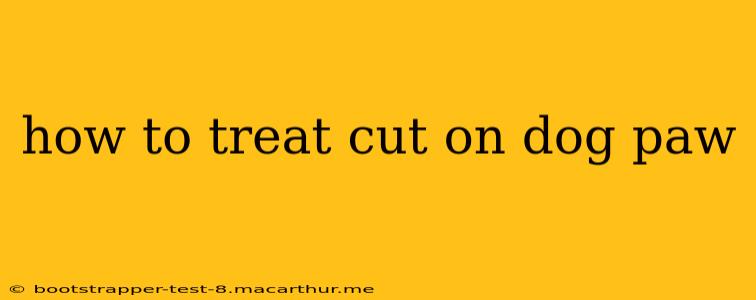A cut on your dog's paw can be distressing for both you and your furry friend. Knowing how to properly treat the wound is crucial to preventing infection and ensuring a speedy recovery. This guide will walk you through the steps, addressing common concerns and providing helpful tips.
How Do I Know if My Dog's Paw Cut Needs Veterinary Attention?
This is the first and most important question. While minor cuts can be treated at home, some injuries require professional veterinary care. Seek immediate veterinary attention if:
- The cut is deep or bleeds profusely. This indicates a potentially serious injury requiring stitches or other interventions.
- You see bone or tendon. These are significant injuries that necessitate professional treatment.
- Your dog is limping excessively or showing signs of pain. This suggests the injury may be more serious than it initially appears.
- The cut is on the paw pad itself, particularly if deep. Paw pads have limited blood supply and are prone to infection.
- The wound shows signs of infection (swelling, redness, pus, or foul odor). Prompt veterinary care is essential to prevent the spread of infection.
- Your dog is exhibiting signs of shock (pale gums, rapid breathing, weakness). This requires immediate veterinary intervention.
How to Clean a Minor Cut on My Dog's Paw at Home?
If the cut is minor and superficial, you can attempt to clean and treat it at home. However, always monitor closely for signs of infection.
-
Restrain your dog safely and gently. A stressed dog may bite or struggle, making treatment more difficult and potentially dangerous. If necessary, enlist help from another person.
-
Assess the wound. Gently examine the cut to determine its depth and severity. If unsure, it's always best to err on the side of caution and seek veterinary advice.
-
Clean the wound. Use lukewarm water and a soft cloth or cotton ball to gently remove any dirt, debris, or foreign material. Avoid using hydrogen peroxide or alcohol, as these can damage the tissues and hinder healing. A mild antiseptic solution, such as diluted chlorhexidine, can be used if recommended by your veterinarian.
-
Apply a thin layer of antibiotic ointment. This helps prevent infection. Many over-the-counter pet-safe ointments are available, but always check the label to ensure it's suitable for dogs.
-
Protect the wound. Consider using a bandage, ideally a self-adhesive one to prevent the dog from licking or chewing it. However, ensure the bandage doesn't restrict blood flow. Frequent monitoring is crucial. In some cases, a vet-recommended cone may be needed.
-
Monitor for signs of infection. Watch for swelling, redness, increased pain, pus, or foul odor. If any of these signs appear, contact your veterinarian immediately.
How Often Should I Change the Bandage?
Bandage changes depend on the severity of the wound and the type of bandage used. Generally, it's recommended to change the bandage daily or as needed if it becomes soiled or wet. Keep the area clean and dry between changes.
What Kind of Bandage Should I Use?
You should use a non-stick, sterile bandage designed for pets. Avoid using human bandages, as these may not be suitable for a dog's paw and could cause irritation or further injury. Consult your veterinarian for recommendations on appropriate bandage material and techniques.
My Dog Keeps Licking Their Paw, What Can I Do?
Licking is a natural dog behavior, but it can interfere with wound healing and increase the risk of infection. If your dog persistently licks their paw despite the bandage, you may need to use a protective cone (Elizabethan collar) to prevent access to the wound. Your veterinarian can advise on the best approach.
When Should I Take My Dog to the Vet After a Paw Cut?
If you are at all concerned about the severity of the wound, or if you notice any signs of infection (swelling, redness, pus, or foul odor), take your dog to the veterinarian immediately. Even minor cuts can become severely infected if not treated properly.
Remember, this information is for guidance only. Always consult your veterinarian for diagnosis and treatment of any injury to your dog. They can provide personalized advice based on your dog's specific needs and the severity of the wound.
